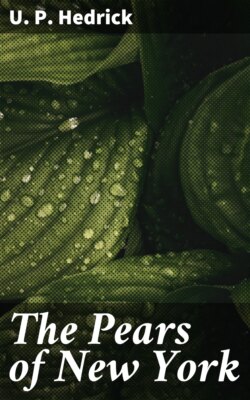Читать книгу The Pears of New York - U. P. Hedrick - Страница 40
На сайте Литреса книга снята с продажи.
BEURRÉ D’ANJOU
ОглавлениеTable of Contents
1. Kenrick Am. Orch. 136. 1841. 2. Downing Fr. Trees Am. 360. 1845. 3. Hovey Fr. Am. 1:61, Pl. 1851. 4. Am. Pom. Soc. Rpt. 53. 1852. 5. Flor. & Pom. 5:1, Pl. 1866. 6. Downing Fr. Trees Am. 679, fig. 1869. 7. Hogg Fruit Man. 510. 1884.
Anjou. 8. Am. Pom. Soc. Cat. 36. 1883.
Winter Meuris. 9. Lucas Tafelbirnen 171, fig. 1894.
Nec plus Meuris. 10. Baltet Cult. Fr. 321, fig. 214. 1908. 11. Guide Prat. 49, 282. 1895.
Beurré d’Anjou is a standard market pear for late fall and early winter, its season lasting until well into January even in common storage. As an early winter pear, it has no superior and few equals in appearance and quality of fruit. In appearance, the pear is of distinct type—large, very uniform, the sides slightly unequal, smooth of skin, yellow, marked and dotted with russet, faintly blushed, and borne on a very short, thick stem. A fruit of this variety can never be mistaken for that of another. The internal characters are scarcely less notable than the external ones. The yellowish-white flesh is firm but tender, slightly granular, very juicy, sweet, spicy, with a rich, vinous flavor. Uniformity of shape and the smooth skin are marked and constant characters. In common with all varieties, the fruits of this pear are not always up to their best, but they are never poor in quality. The trees are vigorous, hardy, fairly free from blight, grow rapidly and come in bearing early, but have the serious fault of being uncertain croppers. In Europe and America, the trees thrive on the quince, and the variety is rated by all as a splendid one for dwarfing. Of all winter pears, none is more valuable for commercial or home orchards than Beurré d’Anjou. In particular, it is recommended for New York, where, possibly, it is more at home than in any other part of America.
Beurré d’Anjou is an old French pear the origin of which is obscure, although it is supposed to have originated in the vicinity of Angers. Early in the nineteenth century it was introduced into England by Thomas Rivers, noted author and pomologist. The variety was introduced into this country by Colonel Wilder[25] of Boston about 1842, and first fruited with him in 1845. The American Pomological Society added Beurré d’Anjou to its list of fruits recommended for general cultivation in 1852.
Tree large, vigorous, spreading, hardy, an uncertain bearer; trunk smooth; branches slightly zigzag, covered with gray scarf-skin over reddish-brown, with few small lenticels; branchlets long, with long internodes, reddish-brown tinged with green, smooth, glabrous, with many conspicuous, raised lenticels.
Leaf-buds small, short, obtuse, nearly free. Leaves 3½ in. long, 1½ in. wide, elongated-oval, thin, leathery; apex taper-pointed; margin nearly entire or crenate; petiole 2 in. long. Flower-buds large, long, conical, plump, free; flowers 1⅜ in. across, showy, in dense clusters, from 8 to 12 buds in a cluster; pedicels ½ in. long, very thick, pubescent, green.
Fruit ripe November to early January; large, 3½ in. long, 3 in. wide, uniform in size, oblong-obovate-pyriform, with surface irregular in outline, sides slightly unequal, uniform in shape; stem ½ in. long, short, very thick and woody; cavity obtuse, shallow, russeted and furrowed, usually lipped; calyx open; lobes separated at the base, long, narrow, acuminate; basin shallow, narrow, obtuse, smooth, symmetrical and regular; skin thin, tender, smooth, dull; color yellow, clouded with russet around the basin and occasionally with very fine russet lines and markings; dots many, small, russet, conspicuous; flesh yellowish-white, firm, but slightly granular, tender, buttery, very juicy, sweet and spicy, with a rich, aromatic flavor; quality very good. Core large, closed; core-lines clasping; calyx-tube short, wide, conical; seeds large, wide, long, plump, acuminate, tufted at the tips.
